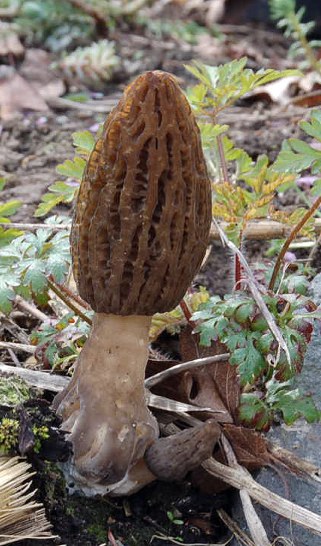Morel Hunt June 16, 2007 First spring after the 2006 Tripod area fire Loup Loup, Okanogan, Northern Cascades, Washington State - USA | |
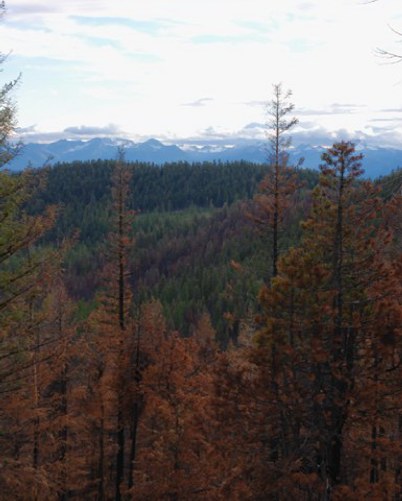 Looking from Beaver Mountain East onto the main chain of the North Cascades. Burned Lodgepole pines (Pinus contorta) and Ponderosa pines (Pinus ponderosa) in foreground. Photo: Looking from Beaver Mountain, Okanogan National Forest, Northern Cascades, Washington State, 1550m (5200 ft), June 16, 2007 © Daniel Winkler | 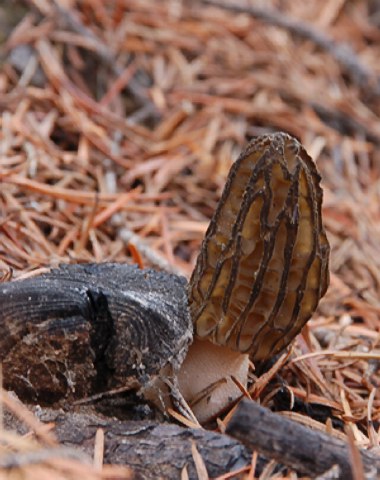 A black burn morel, since April 2012 described as Morchella anthracophila Clowez et D.Winkler, is growing right next to a piece of wood charred during the 2006 60,000 acres (242 sq km) tripod area fire. Interestingly it seems that fire morels need higher temperatures to fruit than regular morels. Photo: Beaver Mountain, Okanogan National Forest, Northern Cascades, Washington State,1710m (5600 ft), June 16, 2007 © Daniel Winkler |
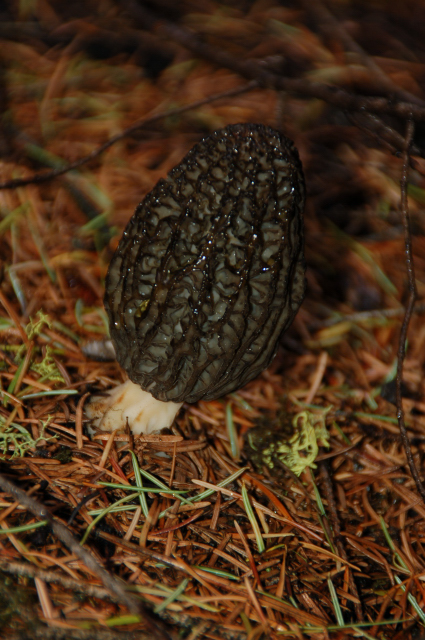 | 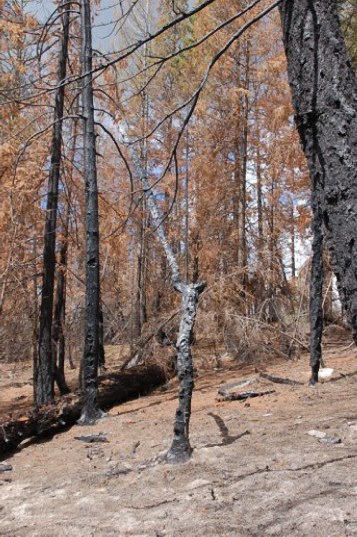 In these completely charred areas we hardly found any morels. Probably their sclerotia, an underground storage tissue, got burned as well. Photo: Beaver Mountain, Okanogan National Forest, Northern Cascades, Washington State, 1550m (5200 ft), June 16, 2007 © Heidi Schor 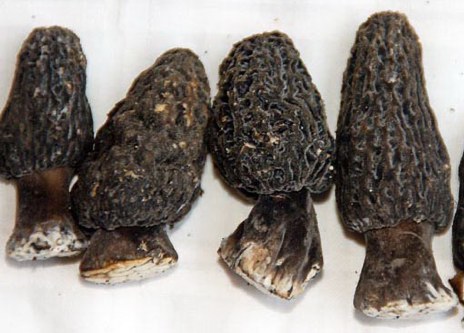 Photo: June 17, 2007 © Daniel Winkler 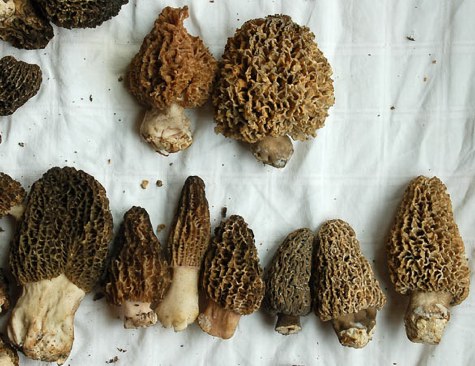 A selection of the morels we picked. Clearly identifiable are the "fuzzy foot morel" or "gray morels" (Morchella tomentosa), whose stalk is dark gray when young [close up below]. It becomes much lighter with maturing, but often remains fuzzy. We found much fewer "grays" to stay with the picker terminology, than "blacks". Most of the morels found were blacks, which are much thinner walled and typical for past-burn mass fruitings. The big morels in this picture are about 15-20cm (6-8in). Photo: June 17, 2007 © Daniel Winkler |
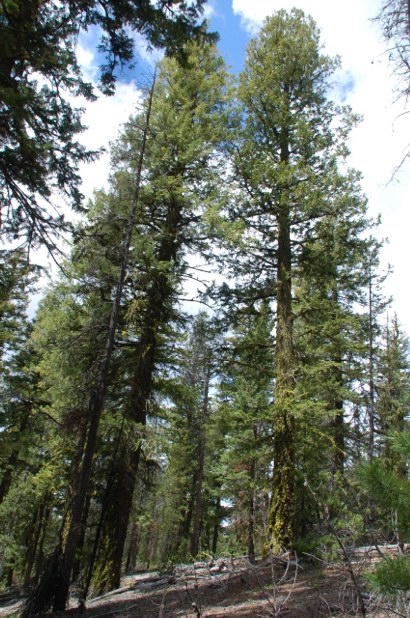 An old growth stand of Douglas firs (Pseudotsuga menziesii) and lodgepole pine (Pinus contorta) right next to the fire site. Photo: Beaver Mountain, Okanogan National Forest, Northern Cascades, Washington State, 1550m (5200 ft), June 16, 2007 © Daniel Winkler Sources: Kuo, Michael 2008. Morchella tomentosa, a new species from western North America, and notes on M. rufobrunnea. In: Mycotaxon 105: 441–446. Pilz, David; McLain, Rebecca; Alexander, Susan; Villarreal-Ruiz, Luis; Berch, Shannon; Wurtz, Tricia L.; Parks, Catherine G.; McFarlane, Erika; Baker, Blaze; Molina, Randy; Smith, Jane E. 2007. Ecology and management of morels harvested from the forests of western North America. Gen. Tech. Rep. PNW-GTR-710. Portland, OR: U.S. Department of Agriculture, Forest Service, Pacific Northwest Research Station. 161 p.Link |
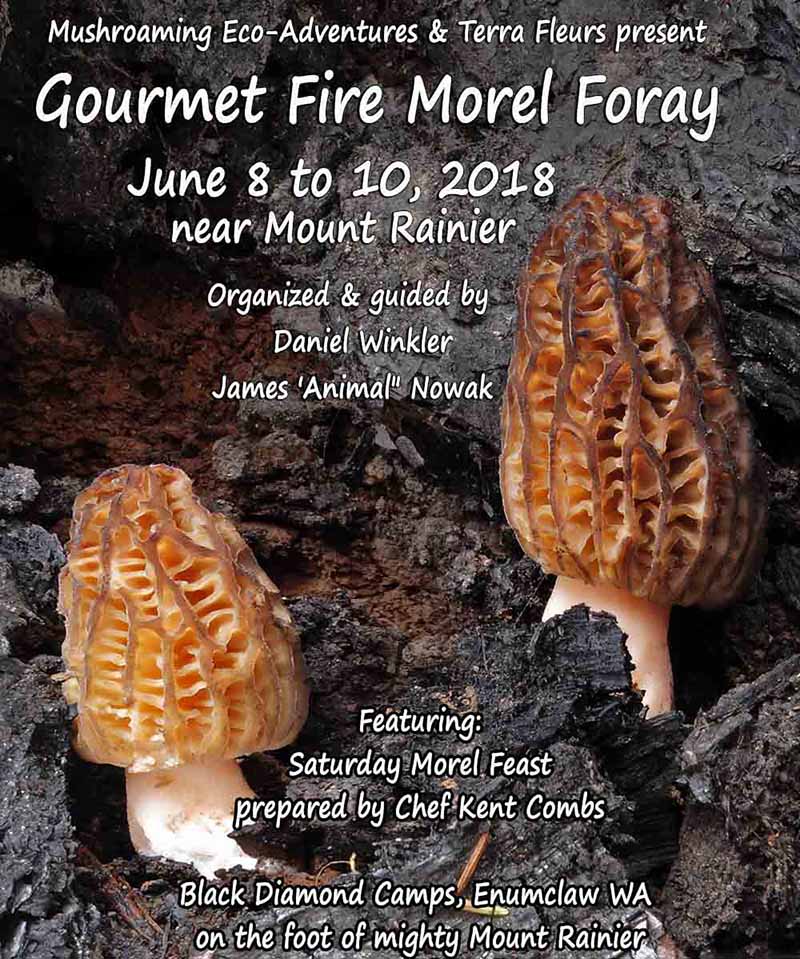
Link to the Gourmet Fire Morel Foray info page
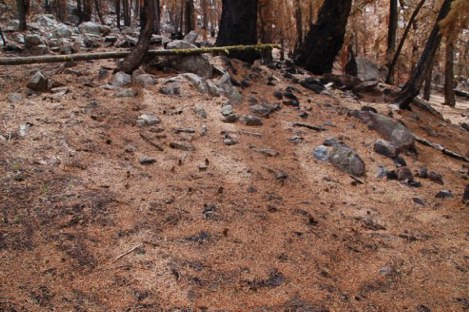 Post-fire fallen Douglas fir needles help to bring out the 7 small morels. Photo: Beaver Mountain, Okanogan National Forest, Northern Cascades, Washington State,1680m (5500 ft), June 16, 2007 © Daniel Winkler | 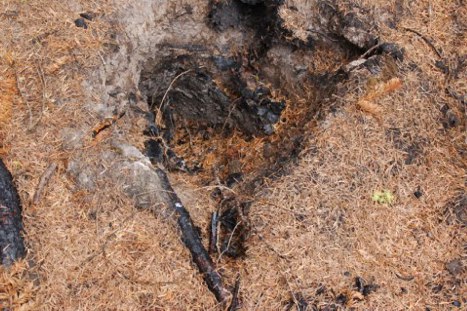 A burned out root stock of a conifer. The area is full of holes from completely burned out stem bases. In this whole 2 morels a fruiting. Photo: Beaver Mountain, Okanogan National Forest, Northern Cascades, Washington State, 1710m (5600 ft), June 16, 2007 © Daniel Winkler |
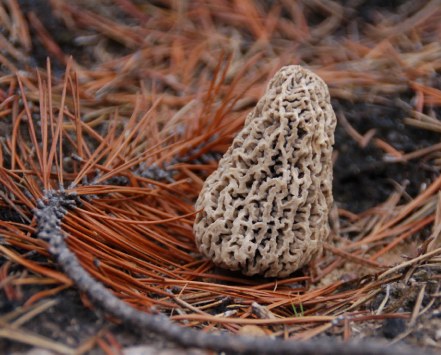 A morel next to a branch of a two-needle pine, possibly lodgepole pine (Pinus contorta). This is an older gray morel (Morchella tomentosa) - they get much lighter in age [see Karl Olson series of pictures of the same specimen over 2 weeks (in Pilz et al. 2007, p. 21)]. At first we erroneously thought this must be a blond morel. Photo: Beaver Mountain, Okanogan National Forest, Northern Cascades, Washington State,1710m (5600 ft), June 16, 2007 © Daniel Winkler | 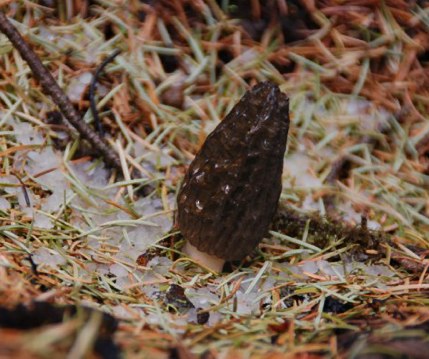 Remnants of a short, but fierce sleet shower collected in a small depression around a black morel. Depressions help increase soil water content and thus are often prime fruiting sites. Photo: Beaver Mountain, Okanogan National Forest, Northern Cascades, Washington State,1710m (5600 ft), June 16, 2007 © Daniel Winkler |
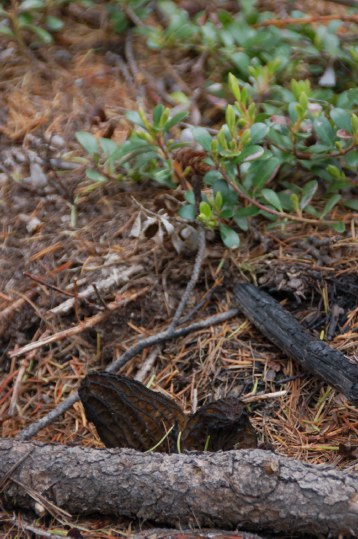 Two black morels right on the edge of burned and unburned ground. In the background Kinnikinnick (meaning mixture in Algonquian, the language of the Delaware Indians) or common bearberry (Arctostaphylos uva-ursi, Heather Family-Ericaceae). Photo: Beaver Mountain, Okanogan National Forest, Washington State, 1550m (5200 ft), June 16, 2007 © Daniel Winkler | 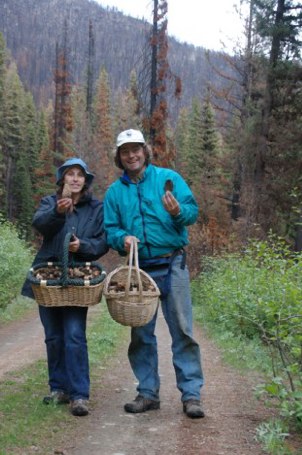 Heidi and I showing off 7 hours of picking and at least as many years of supply of dried morels if we keep up the frequency of cooking them in the past. We had rubbed our hats with mosquito repellents which worked great to keep the swarms of mosquitoes away from our heads. Photo: Beaver Mountain, Okanogan National Forest, Northern Cascades, Washington State,1550m (5200 ft), June 16, 2007 © Daniel Winkler |
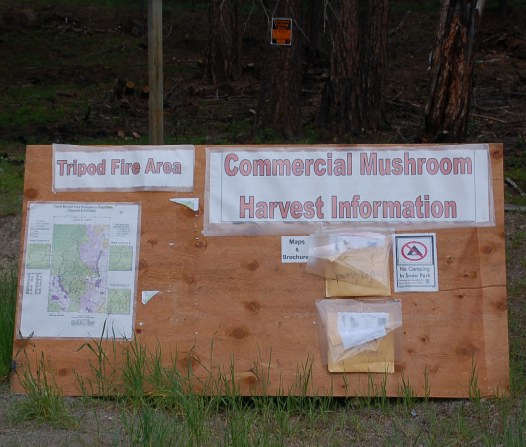 A sign informing commercial mushroom hunters on areas open and closed to picking in the state forest. Leaflets were available in several languages including English, Spanish, Laotian and Khmer (Many commercial pickers are from the Thai, Laotian, Hmong and other SE Asian communities). A permit costs $20 for four days or $100 for the whole season, valid for the Okanogan & Wenatchee National Forests only. Burns attract commercial mushroom hunters, since the morel harvest is bound to be good in the first year after the burn. The income from commercial mushroom picking will not make you rich at all. There are several reasons for deciding to make a living from mushroom picking. For immigrant communities the great advantage is that there is no real disadvantage due to language barriers. Many American-born collectors rather make a living outdoors being their own bosses than in a hierarchical workplace situation. However, the price of relative freedom in the woods requires contentment with very basic living conditions and very meager money. Photo: Near Highway 2, Loup Loup, Okanogan National Forest, Northern Cascades, Washington State, 1250m, 16.6 2007 © Daniel Winkler | 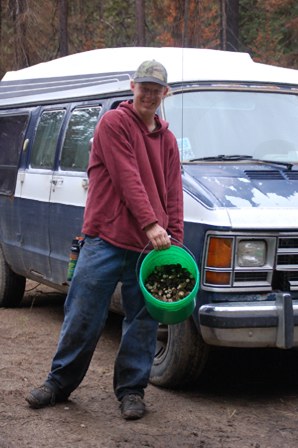 Jason shows 4 hours of hunting. He wasn't very excited about his haul. He thought he was the first one on this road, but it was picked over a week ago. Thus, not many good-sized morels were to be found. However, he liked the gray morels, since they are double-walled and thus heavier. Alas, they are much rarer than the regular burn morels. Mushroom buyers were paying $8 a pound that day. My friend John Goldman checked the morel prices in Seattle the next Monday. At Whole Foods one pound of fresh morels was sold for $40, but at the Farmers market PSMS member Jeremy Faber sold them for much more reasonable $18 per pound. PS: Jason drop me a note, when you have a chance. Photo: Beaver Mountain, Okanogan National Forest, Northern Cascades, Washington State, 1550m, 16.6 2007 © Daniel Winkler |
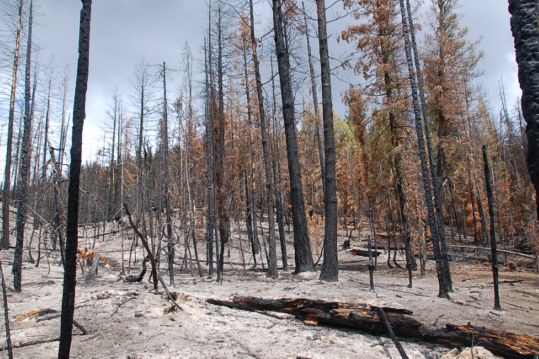 Last Update 5-16-2012 | 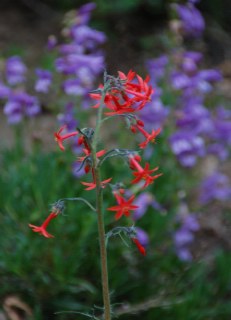 Skyrocket or Scarlet Gilia (Gilia aggregata = Ipomopsis aggregata) in the Phlox family (Polemoniaceae) photographed before a Penstemon on the way out above Loup Loup Camp Ground. Photo: Near Highway 2, Okanogan National Forest, Northern Cascades, Washington State, 1250m, June 16, 2007 © Daniel Winkler |
March 30, 2007 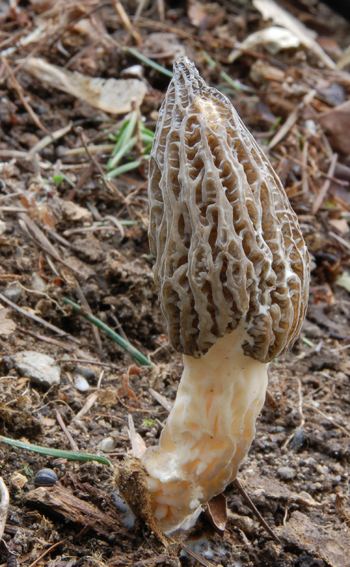 | March 22, 2008 | March 22, 2008 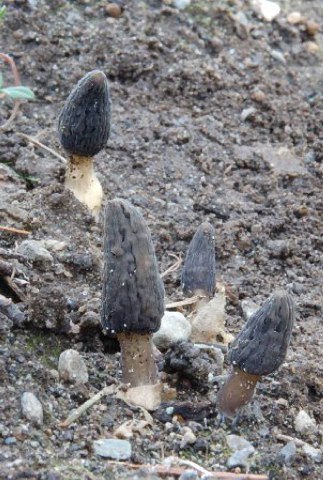 These morels are not taller than 2cm. We will watch them very closely, before we facilitate spore disposal through ingestion. In 2009 we had no fruiting, but in spring 2010 these morels fruited again and lifted their heads out of the dirt already on March 5th. |
The PNW landscape morel, Morchella importuna, popped up in our yard in Kirkland, Washington, last week of March, 2007. Interestingly, the fruiting body grew on top of card box material that was laid out to suppress weed growth. | More or less same spot as the previous year in our yard in Kirkland. These black morels (Morchella importuna) are growing on a pile of topsoil we had moved when adding on 3 years earlier. | Unfortunately the PNW landscape morel, Morchella importuna, is extremely bland in taste. Actually I lost my interest in morel hunting due to its dissapointing taste. In spring 2012 I cooked up a Verpa and this morel and the Verpa had more aroma. At this point I realized it is Morchella importuna that lacks culinary qualities. However most other morels are a great joy to eat! |

